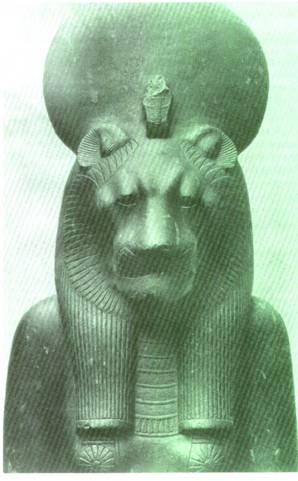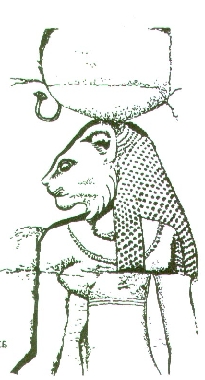|
The White Moon Gallery Presents |

|

|
By Juniper |
|
Sekhmet is the lion-headed solar goddess of the Egyptian pantheon, and the Crone aspect of the trinity of Hathor-Bast-Sekhmet. She is also part of the Triad of Memphis, along with the god, and her consort, and their son Nefer-Tem. Ptah is often called the Creator God, and their son Nefer-Tem is known as the God of Medicine. Ra, the Sun God, was her father. It is widely believed that Sekhmet herself is a much more ancient deity, and in fact, Sekhmet is much older than Ra. It is told that she “came to Egypt from a place unknown and a time unrecorded” (Masters) as shown by some of her titles:
Lady of the Place at the Beginning of Time |

|
The name Sekhmet comes from Sekhem,which means strong, mighty, powerful, and violent. She is a solar goddess, directly related to the creative and destructive powers of the sun.
 The Mythology of Sekhmet
The Mythology of Sekhmet
Sekhmet has something of a bad reputation, stemming largely from a single myth, and as a result, is almost always described in a negative, violent, and overly simplistic way. The myth she is most known for is this:
 |
Humans conspired to overthrow Ra and the other Gods. Even the priests and magicians plotted against the gods, using the powers given them against these gods. Ra heard of this, and called together the most powerful and ancient deities. It was decided that Sekhmet, the “force against which no other force avails” (Masters) should stomp out the rebellion. She would punish all those who had evil in their hearts and minds. So Sekhmet went out and slaughtered the humans, drinking their blood. Soon, the land was so bloody, and so many were dead, that Ra and the gods feared no humans would remain on the earth, so something had to be done to stop Sekhmet, who was intoxicated on human blood and craved even more. Ra sent for a brew to be made from beer, blood, and certain plants – probably containing belladonna and opium – in order to calm and stop Sekhmet. 7000 huge jugs of the brew were prepared, and this bloody-looking liquid was poured over the ground in a place where Sekhmet was sure to go. When Sekhmet came to this place, she thought she saw blood, and drank it all up. Then it is said that “her heart was filled with joy” and her rage and slaughter was ended. After that, Ra praised Sekhmet in order to further soothe her, calling her “the One Who Comes in Peace,” and “beautiful, charming, graceful.” |
This myth came to be celebrated in a festival, a feast day, which occurred in August. Priestesses of Sekhmet served a beverage laced with the plant drugs that Sekhmet herself drank. The priestesses then participated in an orgiastic party. The most famous of these festivals was held at Denderah in the month of Thoth (August). Such festivals were also held following wars and battles, in hopes of soothing Sekhmet’s destructive nature and returning peace to the land. People played, drank, and danced and made love to soothe Sekhmet’s wildness. As a result, Sekhmet eventually was associated with the wild ecstasy of love and sexuality.
Normandi Ellis, in her beautiful book Feasts of Light: Celebrations of the Seasons of Life based on the Egyptian Goddess Mysteries, believes that this myth was probably linked with some actual geological event, which caused the Sahara savannah (lush, green, alive) to turn to Sahara Desert. Life in Egypt shrank to a narrow strip of green on either side of the Nile.
The feast day happens to coincide closely to a change in season and the flooding of the riverbanks, indicating cooler days ahead, and renewed life. The floodwaters of the might be reminiscent of the soothing brew that calmed Sekhmet and ended her rampage. So this feast day was also a celebration of the promise of renewed life to come, and a reminder of the deadly, hot and dry life of summer in the desert.
The festival was also cathartic for the people, allowing them a short time for drunken, orgiastic, wild play and a chance to rid themselves of repressed feelings, anger, and negativity.
 Attributes of Sekhmet
Attributes of Sekhmet
Sekhmet is strongly associated with Kundalini, which is described as unleashed feminine sexuality manifesting as psychic energy, in both women and men (Masters). It is called “Shakti” – the power aspect of the individual. Shakti itself is a Hindu derivation from the name Sekhmet.
Sekhmet has a bad reputation, partly because of the powers and energies she represents. Not only is she associated with violence and blood lust, but also sexual passion and a love of intoxicating drink. She represents not only death, but a very powerful feminine sexuality which definitely frightened people.
In the Book of Revelation, Sekhmet is denounced as the Great Harlot, and called “ Babylon the Great, the Mother of Harlots and of Abominations of the earth.”
Sekhmet is also called “Nesert” meaning Flame, fire as a destroying element. She is also associated with disease, plague, and pestilence. It is said that her priests protected her statues from theft or vandalism by coating them with Anthrax. Still, she was much beloved by the people, as no other deity of ancient Egypt is represented by so many large statues as Sekhmet, and although the main site of her worship was in Memphis, there is evidence of her sacred sites throughout Egypt. Some scholars believe that these statues were widespread in order to invoke her powers as healer and protector against plague, disease, and pestilence (Masters).
Sekhmet is a great healer, sometimes called the Great One of Healing, and her priests and priestesses were known as the greatest healers in the land.
She is both a Goddess of War, and a Goddess of Love. As Flaming One, Sekhmet was said to have the power to totally destroy subtle bodies and souls, so there could be no afterlife, yet she was also known as protector of the dead in the Underworld.
There is a tradition that says there once existed an elaborate system of sexual mysticism and magic originating with Sekhmet that was later lost, or even taken away by Sekhmet, and that kundalini and the chakras were important in this process.
 Hathor-Bast-Sekhmet
Hathor-Bast-Sekhmet
Hathor is the mother, and Sekhmet is the crone aspect of this trinity. Hathor and Bast, in their solar aspects, are sometimes called the “female Ra.” Bast, in her lunar aspect, is the moon goddess who is the twin of Sekhmet, the sun goddess. There is a strong duality between Bast and Sekhmet, so that when lunar qualities are dominant, Bast is manifest as the gentle, nurturing cat-headed goddess. When solar qualities are emphasized, Sekhmet manifests as the lion-headed goddess.
Sekhmet, as the Crone goddess, rules menopause, “a powerful time of self-creation and self-government that could produce visions and create magic” (Ellis). For a woman to use her will and creativity for her own benefit is frightening for some men. The Greeks called her Medusa, and Sekhmet, the Powerful One, now became the Gorgon, or Feared One (Ellis).
|
In terms of the Blood Mysteries, gentle Bast represented ovulation, while fiery Sekhmet represented menstruation! Ellis believes that the rage of Sekhmet is a manifestation of “thwarted energy.” Because women are taught to repress anger and turn it inwards, it builds up – and eventually, that energy has to be released. Sekhmet is transformative power, and we can use her energy in a positive way by learning how to release and express it appropriately. |
 |
Sekhmet is a guardian of the world against evil. Bast is often depicted as a guardian of the home, though she usually wears a lion-headed emblem as a reminder of her Sekhmet aspect – a warning that the gentle, mother Bast can become the fierce lion-headed Sekhmet if necessary!
Sekhmet is also sometimes associated with the snake. The serpent is a sign of the Healer, High Priestess, Shamaness, and Visionary. Snake power is a radical power, both dangerous and transformative (Ellis). As I mentioned, Sekhmet has been associated with the serpent-haired Medusa.
Sekhmet is guardian of the gates of life and death. Each month through the menstrual cycle, a death occurs. Either the ovum is shed, and death occurs that way, or the ovum is fertilized, and a different sort of death occurs – the death of the virgin phase, and a birth into the mother phase of life. Every birth must create a death, and this is the domain of Sekhmet, who wisely chooses what to create and what to destroy.
 The Egyptian Goddess Zodiac
The Egyptian Goddess Zodiac
Shown on the Temple of Hathor in Dendra, this large mural depicts 12 goddesses sitting upon zodiacal thrones.
Sekhmet rules the first house of Aries. She is associated with the element of fire. Attributes of Aries in this system include: warrior goddess qualities, courage, strength, and individual willpower. According to this system, which differs from our modern, traditional system, Aries individuals may be fiery, passionate, impatient, and even short-tempered.
 Sekhmet for Modern Women:
Sekhmet for Modern Women:
There are many reasons you might choose to work with the energies and powers of Sekhmet. Here are but a few:
*Protection
*Banishing
*Dealing with anger, fury, rage
*Dealing with depression
*Working through menopause
*Developing willpower, strength, courage
*Increasing assertive behavior, standing up to people
*Sexual energy
 Correspondences to Sekhmet
Correspondences to Sekhmet
Color: red
Element: Fire
Directions: South and North
Aspect: Crone
Other: Blood, menstruation or menopause, red wines, the sun, wilderness, the desert, snake, lion, heat, red clothing, sexual passion, healing, trance and altered states, solar plexus chakra, willpower
 Sekhmet Activities
Sekhmet Activities
|
* Make a Sekhmet Box: A Sekhmet Box is a container to hold all your rage, anger, and negativity so that you can give it to Sekhmet to burn away in her fires. Find a container with a lid or opening, and color it a bright red. Choose a hot red, and as you paint or color, imagine all your rage pouring into the red. You might like to decorate the box further – images of lions, or snakes, or solar images, and even some gold details would work well. When you need to use the box, light a red candle, and on a piece of paper, write in red ink, the thing (or things) that are making you angry. Put the slips of paper into the Sekhmet box, and leave them. Imagine the flame of your red candle burning these things away. After a period of time that seems right to you, light your red candle again, and pull out the slips of paper and burn them in the flame, releasing them. When you have completed this ritual, do at least one thing that is soothing and comforting to you. Imagine the rage of Sekhmet turned into the gentle purring of Bast. Use the box as many times as you like. |

image from “Feasts of Light” |
*Angry Dolls: This idea comes from Nancy Blair’s Amulets of the Goddess. Her amulet, Gorgon Goddess, is actually a good choice for working with Sekhmet energy, as I mentioned that Sekhmet has a link to Medusa and the Gorgon, also a serpentine Crone goddess associated with raw, wild, female power. Making an “angry doll” is a way to give form to powerful feelings, and allow healing to occur. Gather together materials to make your doll: fabric, beads, ribbons, threads, yarn, whatever you like. Trace the basic shape of the body, and cut out two fabric pieces of these, sewing them right sides together, leaving an opening to turn the body right-side out, and for stuffing. Consider adding soothing herbs to the stuffing. Make her face wild, energetic, and beautiful, and dress her as you wish. Dance with her, use her in ritual, or talk to her, giving her all your anger and negativity to transform. Ask her to show you a better use of that energy.
*A Sekhmet Altar: Sekhmet is strongly aligned with the element of Fire, so her altar would be a fire altar. It should be oriented to the South. Cover the altar with a red cloth. Touches of gold are also appropriate for this solar goddess. Use lots of candles, especially red and gold candles. Images of lions, serpents, Sekhmet, and even Medusa are appropriate, as is red wine.
A Word of Warning:
Obviously, Sekhmet is a powerful Goddess, and can be manifest as a Goddess of Wrath, Disease, and Pestilence. Need I remind you of the “Harm None” rule? Never treat Sekhmet lightly, and never invoke her energies to point your rage in someone’s direction.
 A Sekhmet Ritual For Healing Anger
A Sekhmet Ritual For Healing Anger
Intent: As women, we are taught to keep strong emotions to ourselves, to repress and deny our anger, to be polite, to “take it,” to remain silent. This ritual creates a sacred space for you to acknowledge strong emotion, especially anger, and to offer it to Sekhmet to devour, and transform, so that you can use it in a more positive way - for yourself. It is Sekhmet who provides the will, and the energy to accomplish. She is a passionate fire, if we allow it.
A good time to do this would be during menstruation when Sekhmet energy is likely to
be close to the surface, but any time is appropriate.
Items Needed: Red candles and a red cloth, a cup of red wine or other red beverage
Preparation: Dress
in red clothing. Ancient Priestesses of Sekhmet used
to anoint head, hands, and feet with red as well as lips and cheeks. Consider,
if appropriate, anointing with menstrual blood. Otherwise, prepare for ritual
as you usually do.
Circle: Cast
your circle as you like. Then sit facing the South, light your red candle, and
call upon Sekhmet to witness your ritual.
Body of Ritual: You
have called Sekhmet to be a witness to your ritual,
and to your feelings of anger. Imagine her sitting before you, calm and
listening. Ask yourself where there is anger, and call it forward. Take your
time, and do not be afraid. Allow yourself to feel your anger, as it is a
source of power. Do not dismiss it, or rationalize it away, or tell yourself
you “shouldn’t” feel it, just let yourself feel it. Say, “I am angry.” Let
yourself really feel it. Consider these words from Yoko Ono:

|
Bless you for your anger |
Allow your anger to raise energy, and let it build until you feel ready to release it. Send it to Sekhmet, and imagine it being transformed so that it can be put to better use. Then see yourself receiving it back, in a better form, a healthier form, ready to be used by you. Sit with this for a few moments, and think of the things you can do with this energy. When you are done, thank Sekhmet for being present, for acknowledging your anger. Extinguish your red candle, but save it to use the next time you need to express and release anger. Open your circle as you normally do. Be sure to ground fully.
 References
References
Blair, Nancy.
Amulets of the Goddess: Oracle of Ancient Wisdom, 1993.
Ellis, Normandi. Feasts of Light: Celebrations for the Seasons of Life
based on the Egyptian Goddess Mysteries, 1999.
Ono, Yoko. “Rainbow Revelation,” from her album Star Peace, 1985.
Marashinsky, Amy Sophia. The Goddess Oracle: A Way to Wholeness Through the Goddess and Ritual, 1997.
Masters, Robert. The Goddess Sekhmet: Psychospiritual Exercises of the Fifth Way, 1990